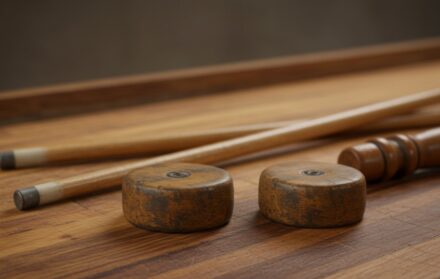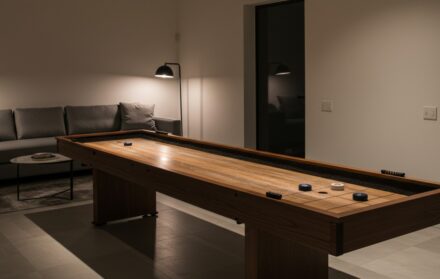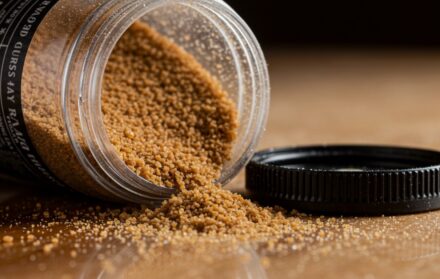
How to Host a Shuffleboard Tournament
Shuffleboard is already a social and entertaining game, but hosting a shuffleboard tournament takes the fun to an entirely new level. A tournament transforms casual matches into an organised event filled with excitement, friendly rivalry, and community spirit. Whether you are a pub owner looking to attract more customers, a club organiser planning a social night, or simply a shuffleboard enthusiast with a home table, knowing how to set up and run a tournament is invaluable.
This guide will walk you on how to host a shuffleboard tournament. From deciding the format and choosing a venue to running matches and awarding prizes, you will have everything you need to host a shuffleboard tournament that feels smooth, fair, and memorable. While players bring their own techniques and styles to the table, your role as organiser is to create the structure and atmosphere that lets the competition shine.
Step 1: Decide the Format of Your Shuffleboard Tournament

The first step is choosing the structure of your tournament. Not all shuffleboard tournaments are alike, and the best format will depend on your audience, the time you have available, and the number of players you expect. Because there are many different shuffleboard variations — from traditional knock-off games to team-based formats and even casual pub-style play — you’ll want to pick a structure that matches both the skill level and the energy of your group.
-
Singles or Doubles: Singles matches are one-on-one, while doubles involve teams of two. Doubles are more social and allow beginners to feel supported, while singles demand more stamina and skill from each player.
-
Casual vs Competitive: Decide if the tournament will be a light-hearted event with flexible rules or a serious competition with strict scoring and referees. Casual tournaments are great for pubs or family gatherings, while competitive ones suit clubs and leagues.
-
Knockout Format: Players are eliminated after each loss until a champion remains. This is simple to run and works best for small to medium groups.
-
Round Robin Format: Each player or team plays everyone else. This ensures more playtime but requires more scheduling. Ideal for groups of 6–12.
-
Hybrid Formats: Start with round robin groups, then move to knockout finals. This combines fairness with excitement.
Example: With 8 players, you can run quarter-finals, semi-finals, and a final in just one evening. With 12 players, a round robin of three groups works better, followed by semi-finals.
Step 2: Choose the Best Venue for a Shuffleboard Tournament
Your venue will determine how enjoyable and practical your tournament feels.
-
Space Requirements: A shuffleboard table needs at least 2 feet of clearance at each end for players to shoot comfortably and around 2 feet on each side for movement. For deck shuffleboard, ensure the full court is clear and that spectators can gather safely.
-
Lighting: Good lighting is critical. Overhead lights should illuminate scoring zones clearly so disputes are minimised.
-
Atmosphere: Pubs and clubs provide a lively backdrop, while home tournaments can feel cosy and personal. On cruise ships, deck tournaments are often paired with music and announcements.
-
Seating and Refreshments: Make sure participants and spectators have somewhere to relax between matches. For pubs, this is a great opportunity to pair food and drink packages with the event.
Step 3: Gather the Equipment You Need for a Shuffleboard Tournament
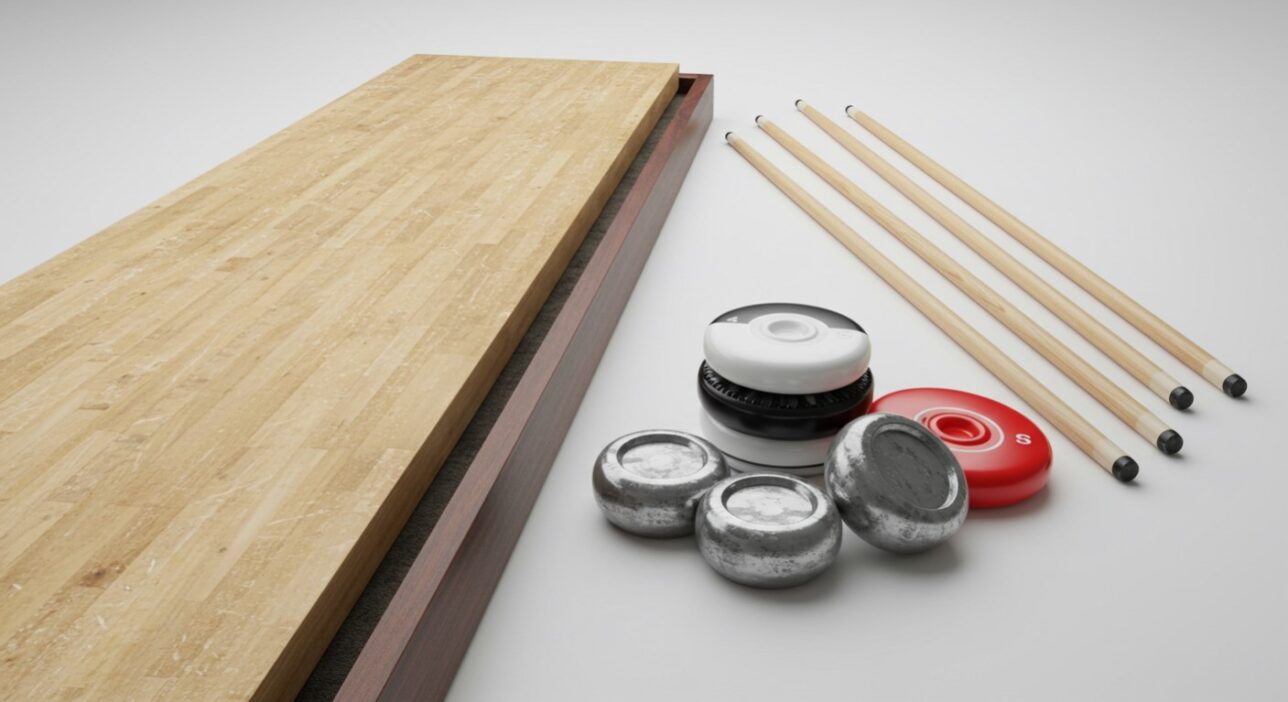
Even the best-planned tournament will stumble without proper equipment. Prepare everything in advance.
Essential checklist:
-
Shuffleboard table(s) or deck court(s).
-
Complete set of 8 pucks/discs (red and blue), plus spares in case of damage.
-
Shuffleboard wax or powder for tables.
-
Brushes to clear old wax between games.
-
Scoreboards or digital scoring apps.
-
Covers to protect tables during breaks.
-
Referee tools such as clipboards and pens.
-
Prizes: trophies, medals, or novelty awards like “Best Shot of the Night.”
Having spares for pucks and accessories prevents avoidable delays if something goes missing mid-event.
Step 4: Set the Rules for Your Shuffleboard Tournament
Clear rules prevent confusion and disputes. Decide these before the tournament and make sure every player understands them.
-
Scoring: For table shuffleboard, games are usually played to 15 or 21 points. For deck shuffleboard, most games go to 75 points or 8–10 rounds.
-
Foul Line: Pucks must be released from behind the foul line. Any puck thrown incorrectly should be removed from play.
-
Scoring Validity: A puck must fully cross the scoring line to count. Hangovers at the edge of the table may be worth extra points if they don’t fall.
-
Ties: Decide in advance whether ties are resolved with an extra round or sudden-death play.
-
Etiquette: No distracting opponents during shots, and disputes are resolved by the referee or organiser.
Write these rules down and display them prominently so all participants are on the same page.
Step 5: Create a Shuffleboard Tournament Schedule and Bracket

A well-structured schedule keeps everything running smoothly.
-
Player Count: Base your schedule on the number of players. 8–16 is ideal for one-night events; larger groups may need multiple days.
-
Brackets: For knockout tournaments, create a bracket showing who plays whom in each round. For round robin, prepare a table showing all matchups.
-
Software and Apps: Online bracket generators or even printed charts work well. Display them clearly so everyone can track progress.
-
Rest Time: Build in breaks between games, especially if players have back-to-back matches. This keeps play fair and prevents fatigue.
Example: With 16 players, run four groups of four in a round robin. The top two from each group advance to quarter-finals.
Step 6: Prepare the Shuffleboard Table Before the Tournament
Nothing frustrates players faster than a poorly prepared table.
-
Brushing: Before every round, brush off old wax to ensure smooth play.
-
Waxing: Apply a fresh, even layer of shuffleboard wax or powder to create consistent glide.
-
Levelling: Use a spirit level to check that the table surface is flat. Adjust legs or climate adjusters as needed.
-
Testing: Slide a puck down the length of the table to confirm smooth, even movement.
-
Deck Courts: For deck shuffleboard, ensure the painted triangles are clear, visible, and free of debris.
A well-prepared table sets the tone for fairness and professionalism.
Step 7: Run the Shuffleboard Tournament Smoothly
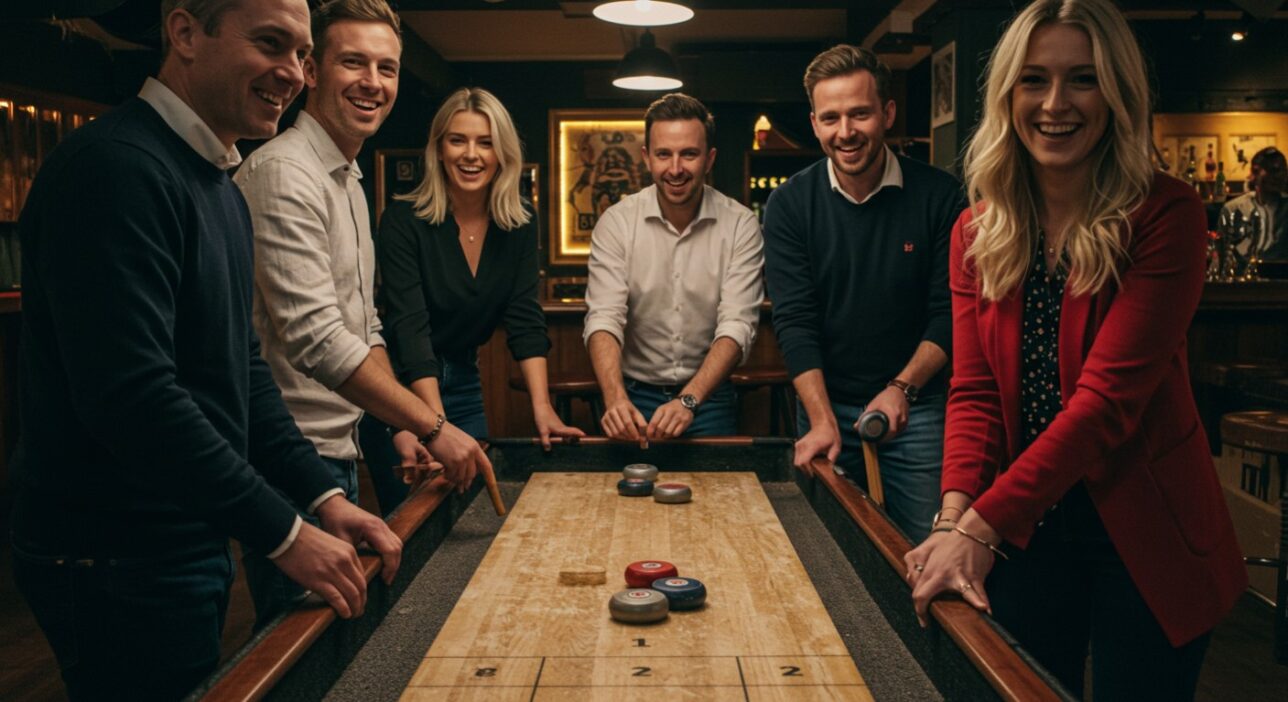
Now comes the most important part: keeping the event flowing.
-
Assign an organiser or referee to manage the schedule, call players, and oversee disputes.
-
Keep matches on time. Announce games clearly so no one misses their turn.
-
Record results immediately after each game to avoid confusion.
-
Create atmosphere: use music, light commentary, or themed decorations to keep energy levels high.
-
Encourage spectators to cheer respectfully, adding to the excitement.
Smooth organisation makes even casual tournaments feel professional and fun.
Step 8: Handle Fair Play and Disputes During a Shuffleboard Tournament
Even with clear rules, disagreements can happen. Be prepared to handle them quickly.
-
Sportsmanship First: Encourage players to treat each other with respect.
-
Final Word: The organiser’s decision should be final to prevent endless debates.
-
Rotating Referees: For larger tournaments, appoint multiple referees to ensure impartiality.
-
Casual Events: If it’s a pub or family night, prioritise fun — bend rules slightly if it helps maintain enjoyment.
By addressing disputes fairly, you maintain trust in the competition.
Step 9: Add Fun Extras to Your Shuffleboard Tournament

Prizes and extras make tournaments more memorable.
-
Prize Categories: Beyond champion trophies, add awards like “Best Shot,” “Funniest Miss,” or “Most Improved Player.”
-
Themes: Consider retro shuffleboard nights, fancy dress themes, or even holiday specials like Christmas or Halloween tournaments.
-
Food and Drink Packages: In pubs, entry fees that include a pint or meal can boost participation.
-
Charity Angle: Use the tournament to raise funds for local causes. Players feel more invested when supporting a good purpose.
These touches turn an ordinary event into something people look forward to repeating.
Step 10: Celebrate and Wrap Up Your Shuffleboard Tournament
The way you close the event leaves a lasting impression.
-
Host a small award ceremony to crown winners and hand out prizes.
-
Thank participants and spectators for attending.
-
Take photos and share results on social media or community notice boards.
-
Collect feedback about what players enjoyed and what could be improved for next time.
Ending on a celebratory note ensures players remember the event fondly and spread word of mouth.
Conclusion: How To Host a Shuffleboard Tournament

Hosting a shuffleboard tournament doesn’t have to be complicated. By following clear steps — defining the format, preparing the venue, gathering equipment, setting rules, building a schedule, and running matches fairly — anyone can organise an event that is smooth, exciting, and enjoyable for all involved.
Whether you’re planning a small pub night, a family gathering, or a competitive club tournament, the key is structure and atmosphere. Keep it fair, keep it fun, and add personal touches like creative prizes or themes. Do this, and your shuffleboard tournament will not just be a one-off event but the start of a tradition that players eagerly anticipate each year.

